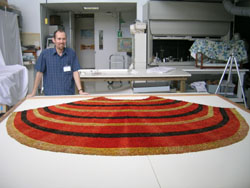
Historical genetic profiles for Hawaiian bird populations: genotyping feathers from museum material
Principal Investigator: Dr Jim Groombridge
Post-doctoral Research Associate: Dr Sarah Anderson
Introduction
Global biodiversity is experiencing a dramatically high extinction rate unprecedented in its severity, and human impact now ensures that extinction continues to threaten our remaining species diversity. It is therefore important for conservation biologists to understand the genetic contributions to a species’ decline towards eventual extinction.
Experiments using model species, either in the laboratory or in closely studied field sites, have provided a clear picture of how loss of genetic diversity, and increased inbreeding at the DNA level, can increase the chances of a population becoming extinct. However, few studies have examined whether this picture holds true for actual species extinctions that have been well-documented over the last 200 years.
An ideal way forward is to examine changes in genetic diversity contained within DNA across time, and to repeat this for species that are alive today and for comparable species that have recently gone extinct. Museum collections of bird skins, collected by early travellers and naturalists during the last two centuries, are an ideal source of genetic material. Museums today contain many extinct species of Hawaiian honeycreepers, a group of forest bird species famous for their diversity of plumage and bill-shapes.
Hawaiian birds are an ideal set of species with which to study extinction, because a large proportion of Hawaiian birds are known to have gone extinct, and detailed historical records exist that document their recent disappearances from these isolated, oceanic islands. Hawaiian honeycreepers are an excellent choice because comparable genetic material can also be extracted from ancient ceremonial capes, which are constructed of Hawaiian honeycreeper feathers. Several of these capes were presented to Captain Cook upon his discovery of Hawaii in 1778, and can therefore be dated at more than 230 years old. The capes contain feathers from several extinct honeycreeper species, as well as those from two species that are still alive today. This mixture of species is very fortunate, allowing us to compare changes in the level of genetic diversity across 230 years, for extinct and living species.
This project therefore focuses on microsatellite DNA diversity in two extinct and two extant species, from museum samples spanning two centuries. Historical genetic data will be compared with those for modern, living populations of surviving species, to identify patterns between levels of genetic diversity and extinction. The projects findings will be interpreted alongside demographic and distributional data for these species that is available from historical records.
The potential findings from this project will inform conservation practitioners of the role of genetic processes in recent, documented extinctions relative to demographic factors. This project will also serve to emphasise the important contribution that museum collections can make to conservation science, and recovery of endangered species. This project involves collaboration with the NERC molecular genetics facility at the University of Sheffield, researchers at Queen Mary, University of London, the Smithsonian National Museum of Natural History, and with museums in the UK and US, including the Bishop Museum in Hawaii.